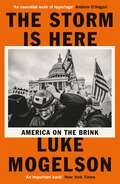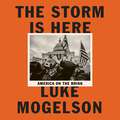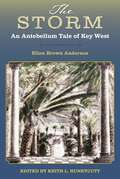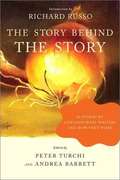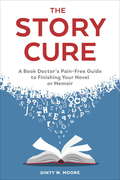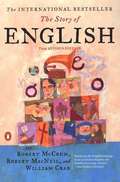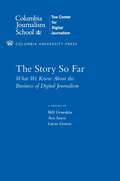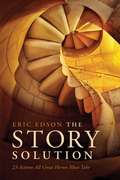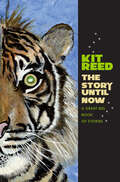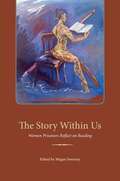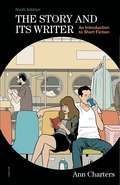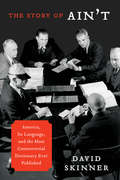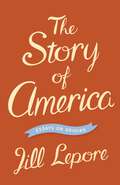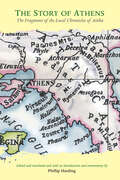- Table View
- List View
The Storm is Here: America on the Brink
by Luke MogelsonThe New Yorker's award-winning war correspondent returns to his own country to chronicle a story of mounting civic breakdown and violent disorder, in a vivid eyewitness narrative of revelatory explanatory power.'This is a searing book, exquisitely reported, lyrically told, and so vivid it will make your heart stop-a dark journey into what ails America' Patrick Radden KeefeOn the morning of January 6, a gallows was erected on the National Mall in Washington, D.C. A little after noon, as thousands of Trump supporters marched past the structure, some paused to climb its wooden steps and take pictures of the US Capitol framed within an oval noose. Up ahead, the dull thud of stun grenades could be heard, accompanied by bright flashes. Several people carried Confederate flags. Others had Tasers, baseball bats, bear spray, and truncheons. 'They need help!' a man shouted. 'It's us versus the cops!' No one seemed surprised by what was taking place. There was an eerie sense of inexorability, mixed with nervous hesitation. It reminded me of combat: the slightly shocked, almost bashful moment when bravado, fantasy, and training crash against reality.In early 2020, Luke Mogelson, who had been living in France and covering the Global War on Terrorism, returned home to report on the social discord that the pandemic was bringing to the fore in the US. Soon, he found himself embedded with militias descending on the Michigan state capitol. From there, the story swept him on to Minneapolis, then to Portland, and ultimately to Washington, D.C. His stories for The New Yorker were hailed as essential first drafts of history. They were just the tip of the iceberg.The Storm Is Here is the definitive eyewitness account of how--during a season of sickness, economic uncertainty, and violence--a large segment of Americans became convinced that they needed to rise up against dark forces plotting to take their country away from them, and then did just that. It builds month by month, through vivid depictions of events on the ground, from the onset of the pandemic to the attack on the US Capitol--during which Mogelson was in the Senate chamber with the insurrectionists--and its aftermath. Bravely reported and beautifully written, Mogelson's book follows the tradition of some of the essential chronicles of war and unrest of our time.
The Storm is Here: America on the Brink
by Luke MogelsonThe Storm is Here is a record of a year that changed America.The New Yorker's award-winning war correspondent returns to his own country to chronicle a story of mounting civic breakdown and violent disorder, in a vivid eyewitness narrative of revelatory explanatory powerOn the morning of January 6, a gallows was erected on the National Mall in Washington, D.C. A little after noon, as thousands of Trump supporters marched past the structure, some paused to climb its wooden steps and take pictures of the US Capitol framed within an oval noose. Up ahead, the dull thud of stun grenades could be heard, accompanied by bright flashes. Several people carried Confederate flags. Others had Tasers, baseball bats, bear spray, and truncheons. 'They need help!' a man shouted. 'It's us versus the cops!' No one seemed surprised by what was taking place. There was an eerie sense of inexorability, mixed with nervous hesitation. It reminded me of combat: the slightly shocked, almost bashful moment when bravado, fantasy, and training crash against reality.In early 2020, Luke Mogelson, who had been living in France and covering the Global War on Terrorism, returned home to report on the social discord that the pandemic was bringing to the fore in the US. Soon, he found himself embedded with militias descending on the Michigan state capitol. From there, the story swept him on to Minneapolis, then to Portland, and ultimately to Washington, D.C. His stories for The New Yorker were hailed as essential first drafts of history. They were just the tip of the iceberg.The Storm Is Here is the definitive eyewitness account of how--during a season of sickness, economic uncertainty, and violence--a large segment of Americans became convinced that they needed to rise up against dark forces plotting to take their country away from them, and then did just that. It builds month by month, through vivid depictions of events on the ground, from the onset of the pandemic to the attack on the US Capitol--during which Mogelson was in the Senate chamber with the insurrectionists--and its aftermath. Bravely reported and beautifully written, Mogelson's audiobook follows the tradition of some of the essential chronicles of war and unrest of our time.(P) 2022 Penguin Audio
The Storm: A Novel
by Frederick BuechnerThe Boston Globe calls Frederick Buechner "one of our finest writers." USA Today says he's "one of our most original storytellers." Now this acclaimed author gives us his most beguiling novel yet--a magical tale of love, betrayal, and redemption inspired by Shakespeare's The Tempest.On wealthy Plantation Island in South Florida, an old man waits, Kenzie Maxwell is a writer, a raconteur, a rascal, an altruist, a mystic--a charismatic figure who enjoys life with his rich third wife but muses daily on the sins of his past. Two decades ago, Kenzie had to leave New York because of a scandal. He'd been a volunteer at a runawat shelter, and he'd fallen in love with a seventeen-year-old girl--a girl who died while giving birth to Kenzie's daughter. His older brother, Dalton, a lawyer and board member at the shelter, decided to quell the rumors by releasing Kenzie's note of apology to the press. Kenzie's reputation--and the girl's--were destroyed. He has never forgiven his brother.Now it's the eve of Kenzie's seventieth birthday, and a storm is brewing. His beloved daughter, Bree--the child of the scandal--is coming down from New York for his birthday party. But his brother Dalton is coming down, too, to do some legal work for the island's ill-tempered matriarch. Aided and abetted by Dalton's happy-go-lucky stepson, a loutish gardener, a New Age windsurfer, a bumbling bishop, and a bona fide tempest, Kenzie must somehow contrive to reconcile with his brother--and make peace with his past.Infused with humanity, and informed by faith. The Storm is Frederick Buechner's most captivating novel since Godric--a richly satisfying contemporary story of fragmented families and love's many mysteries that will move you, makeyou laugh, and fill you with wonder.
The Storm: An Antebellum Tale of Key West
by Ellen Brown AndersonA newly discovered manuscript believed to be the first known novella written by a woman in Florida In 2015, an unsigned and undated 98-page manuscript was donated to the University of Florida. This work, titled The Storm, is published here for the first time, transcribed and annotated by Keith Huneycutt. Huneycutt presents evidence attributing its authorship to Ellen Brown Anderson, a writer who came to Florida and lived with family members before the Civil War. This book makes widely available what may be the first novella written by a woman in the state.Likely written between 1854 and 1862, The Storm is set in Key West during the hurricane year of 1846. It is narrated by a young bride who tells the story of her first marriage, her struggle to make sense of a loveless and hopeless domestic situation, and the restrictions placed on women in her society. The story also presents a woman’s viewpoint on mid-nineteenth-century Key West, including the island’s shipwreck salvage industry and the town’s get-rich-quick economy, constituting one of the first fictional treatments of the Keys’ wrecking business.Huneycutt’s introduction compares the text with other examples of women’s literature and works by Florida authors from the period. The appendixes include essays on the writings of Anderson and her sister Corrina Brown Aldrich, who may have also played a role in the tale’s creation. Huneycutt argues that The Storm is groundbreaking in many ways and that it deserves serious consideration as part of antebellum American literature.
The Story Behind the Story: 26 Stories by Contemporary Writers and How They Work
by Richard Russo Peter TurchiThis big, beautiful anthology of short fiction is for readers, writers, and anyone curious about the mysterious processes of literary minds. All contributors have been recent faculty members of the prestigious Warren Wilson Low Residency Program, including such literary favorites as Margot Livesey, Charles Baxter, Robert Boswell, Jim Shepard, Antonya Nelson, David Shields, and the editors themselves. Each writer was asked to submit an original story, accompanied by an essay describing the challenges of the story and how they were met. Since writers resist herding, the editors were happily surprised by the wide range of essays "fiction writers, when given the space, think about their work very differently. " We learn about the genesis of a story, how story evolves, what was eventually relinquished and why, and how a story surprisingly might "insist" on changing. Arranged alphabetically by author, and beginning with Richard Russo's cogent introduction, this volume is a treasure throughout.
The Story Cure: A Book Doctor's Pain-Free Guide to Finishing Your Novel or Memoir
by Dinty W. MooreA collection of cures for writer's block, plotting and characterization issues, and other ailments writers face when completing a novel or memoir, prescribed by the director of creative writing at Ohio University.People want to write the book they know is inside of them, but they run into stumbling blocks that trouble everyone from beginners to seasoned writers. Drawing on his years of teaching at both the university level and at writing workshops across the country, Professor Dinty W. Moore dons his book-doctor hat to present an authoritative guide to curing the issues that truly plague writers atall levels. His hard-hitting handbook provides inspiring solutions for diagnoses such as character anemia, flat plot, and silent voice, and is peppered with flashes of Moore's signature wit and unique take on the writing life.
The Story Factor: Inspiration, Influence, and Persuasion through the Art of Storytelling
by Annette SimmonsFully revised, updated, and expanded, this modern classic will teach you to use the art of storytelling to persuade, motivate, and inspire in life and business Anyone seeking to influence others must first know their own story, and how to tell it properly. Whether you're proposing a risky new venture, trying to close a deal, or leading a charge against injustice, you have a story to tell. Tell it well and you will create a shared experience with your listeners that can have profound results.In this modern classic, Annette Simmons reminds us that the oldest tool of influence is also the most powerful. Fully revised and updated to account for new technology and social media, along with two new chapters on the role of stories in the development of civilization and how to adjust your story to your specific goal, Simmons showcases over a hundred examples of effective storytelling drawn from the front lines of business and government, as well as myths, fables, and parables from around the world. Whether writing a screenplay, or announcing a corporate reorganization, Simmons illustrates how story can be used in ways that cold facts, bullet points, and directives can't. These stories, combined with practical storytelling techniques, show anyone how to become a more effective communicator and achieve their goals.
The Story Is True: The Art and Meaning of Telling Stories
by Bruce JacksonMaking and experiencing stories, remembering and retelling them is something we all do. We tell stories over meals, at the water cooler, and to both friends and strangers. But how do stories work? What is it about telling and listening to stories that unites us? And, importantly, how do we change them-and how do they change us? InThe Story Is True, author, filmmaker, and photographer Bruce Jackson explores the ways we use the stories that become a central part of our public and private lives. He examines, as no one before has, how stories narrate and bring meaning to our lives, by describing and explaining how stories are made and used. The perspectives shared in this engaging book come from the tellers, writers, filmmakers, listeners, and watchers who create and consume stories. Jackson writes about his family and friends, acquaintances and experiences, focusing on more than a dozen personal stories, from oral histories, such as conversations the author had with poet Steven Spender, to public stories, such as what happened when Bob Dylan "went electric"at the 1965 Newport Folk Festival. Jackson also investigates how "words can kill," showing how diction can be an administrator of death, as in Nazi extermination camps. And finally, he considers the way lies come to resemble truth, showing how the stories we tell, whether true or not, resemble truth to the teller. Ultimately,The Story Is Trueis about the place of stories-fiction or real-and the impact they have on the lives of each one of us.
The Story Of English, Third Revised Edition
by Robert Macneil Robert Mccrum William CranNow revised, The Story of English is the first book to tell the whole story of the English language. Originally paired with a major PBS miniseries, this book presents a stimulating and comprehensive record of spoken and written English—from its Anglo-Saxon origins some two thousand years ago to the present day, when English is the dominant language of commerce and culture with more than one billion English speakers around the world. From Cockney, Scouse, and Scots to Gulla, Singlish, Franglais, and the latest African American slang, this sweeping history of the English language is the essential introduction for anyone who wants to know more about our common tongue.
The Story Performance Handbook
by R. Craig RoneyThe Story Performance Handbook provides specific, detailed information to help adults develop basic skills in reading aloud, mediated storytelling, and storytelling. Organized sequentially, each chapter moves the reader from the easiest (reading aloud picture books) to the most difficult (creating your own stories for telling) storytelling experience, cumulatively building story performance skill in selecting, preparing, and delivering stories and poetry to audiences. This structure allows individuals to begin reading at various points depending on their prior experience with story performance. The text includes several features that make learning to perform stories and poetry easy to understand and manage: * Explicit, thorough advice avoids confusion, such as how to select, prepare, and deliver stories and poetry via reading aloud, mediated storytelling, and storytelling. * The sequential chapter organization, progressing from easiest to most difficult, and Developmental and Culminating Activities at the end of each skill chapter, enable this text to be used either independently or in conjunction with courses or workshops in story performance. * Unique among story performance texts, instruction is based not only on the author's own extensive experience but also on empirical research related to teaching adults to tell stories. * Specific information is easily located throughout the text: Processes are presented in bold type, numbered sequentially and, at the end of specific chapters, skill building activities are provided. Figures (which provide additional detailed information) are boxed. Examples of processes are highlighted with background shading.
The Story So Far: What We Know About the Business of Digital Journalism (Columbia Journalism Review Books)
by Ava Seave Bill Grueskin Lucas GravesBill Grueskin, Ava Seave, and Lucas Graves spent close to a year tracking the reporting of on-site news organizations-some of which were founded over a century ago and others established only in the past year or two-and found in their traffic and audience engagement patterns, allocation of resources, and revenue streams ways to increase the profits of digital journalism. In chapters covering a range of concerns, from advertising models and alternative platforms to the success of paywalls, the benefits and drawbacks to aggregation, and the character of emerging news platforms, this volume identifies which digital media strategies make money, which do not, and which new approaches look promising. The most comprehensive analysis to date of digital journalism's financial outlook, this text confronts business challenges both old and new, large and small, suggesting news organizations embrace the unique opportunities of the internet rather than adapt web offerings to legacy business models. The authors ultimately argue that news organizations and their audiences must learn to accept digital platforms and their constant transformation, which demand faster and more consistent innovation and investment.
The Story Solution: 23 Actions All Great Heroes Must Take
by Eric EdsonEric Edson has developed a new tool for bringing depth and passion to any screenplay - the ""23 Steps All Great Heroes Must Take."" It's an easy to understand paradigm that provides writers and filmmakers the interconnecting, powerful storytelling elements they need. With true insight, a master teacher of screenwriting pinpoints the story structure reasons most new spec scripts don't sell; then uses scores of examples from popular hit movies to present, step by step, his revolutionary Hero Goal Sequences blueprint for writing blockbuster movies.
The Story Until Now: A Great Big Book of Stories
by Kit ReedThe best stories from a master of speculative fiction Called "one of our brightest cultural commentators" by Publishers Weekly, Kit Reed draws from life—with a difference. This new collection brings together thirty-four of her strong, original stories, from early classics like "The Wait" and "Winter" to six never-before-collected short stories, including "The Legend of Troop 13" and "Wherein We Enter the Museum." An early favorite, "Automatic Tiger," is the first in a series of Reed's stories about animals. There's a monkey who grinds out bestsellers with the help of a "creative writing" app. Her uncanny black dog can enter a crowded room and sit down at the feet of the next man to die. Her characters confront war in various arenas: mother/daughter battles, the war of the sexes, the struggles of men scarred by war. Kit Reed's self-described "transgenred" fiction is confirmation of an "extraordinary talent" (The Financial Times). The range and complexity of her work speaks for itself in The Story Until Now.
The Story Within Us: Women Prisoners Reflect on Reading
by Megan SweeneyThe Story Within Us: Women Prisoners Reflect on Reading features in-depth, oral interviews with eleven incarcerated women, each of whom offers a narrative of her life and her reading experiences within prison walls. The women share powerful stories about their complex and diverse efforts to negotiate difficult relationships, exercise agency in restrictive circumstances, and find meaning and beauty in the midst of pain. Their shared emphases on abuse, poverty, addiction, and mental illness illuminate the pathways that lead many women to prison and suggest possibilities for addressing the profound social problems that fuel crime. Framing the narratives within an analytic introduction and reflective afterword, Megan Sweeney highlights the crucial intellectual work that the incarcerated women perform despite myriad restrictions on reading and education in U.S. prisons. These women use the limited reading materials available to them as sources of guidance and support and as tools for self-reflection and self-education. Through their creative engagements with books, the women learn to reframe their own life stories, situate their experiences in relation to broader social patterns, deepen their understanding of others, experiment with new ways of being, and maintain a sense of connection with their fellow citizens on both sides of the prison fence.
The Story You Need to Tell: Writing to Heal from Trauma, Illness, or Loss
by Sandra MarinellaA practical and inspiring guide to transformational personal storytelling, The Story You Need to Tell is the product of Sandra Marinella’s pioneering work with veterans and cancer patients, her years of teaching writing, and her research into its profound healing properties. Riveting true stories illustrate Marinella’s methods for understanding, telling, and editing personal stories in ways that foster resilience and renewal. She also shares her own experience of using journaling and expressive writing to navigate challenges including breast cancer and postpartum depression. Each of the techniques, prompts, and exercises she presents helps us “to unravel the knot inside and to make sense of loss.”
The Story and Its Writer: An Introduction To Short Fiction (Tenth Edition)
by Ann ChartersAnn Charters has an acute sense of which stories work most effectively in the classroom and knows that writers, not editors, have the most interesting and useful things to say about the making and the meaning of fiction. Instructors look forward to every new edition of her bestselling anthology to see what stories her constant search for new fiction and neglected classics will turn up. <p><p> To complement the stories, Charters includes her signature innovation: an array of the writers’ own commentaries on the craft and traditions of fiction. The six Casebooks provide in-depth, illustrated studies of particular writers or genres, for unparalleled opportunities for discussion and writing. The new, trimmer, tenth edition features many very recent stories and commentaries by up-and-coming writers; a new Casebook on short shorts or flash fiction; and an expanded focus on why we read, study, and write about short fiction.
The Story and Its Writer: An Introduction to Short Fiction (7th Edition)
by Ann ChartersThis is a book containing a wide variety of short stories by a wide selection of authors. It also contains commentaries by other authors on most included, as well as sections on writing short fiction and literary criticism. It also contains a glossary of literary terms.
The Story and Its Writer: An Introduction to Short Fiction (Compact 7th edition)
by Ann ChartersDuring her many years of teaching introduction to fiction courses, Ann Charters developed an acute sense of which stories work most effectively in the classroom. She also discovered that writers, not editors, have the most interesting and useful things to say about the making and the meaning of fiction. Accordingly, her choice of fiction in the first edition of her The Story and Its Writer was as notable for its student appeal as it was for its quality and range. And to complement these stories, she introduced a lasting innovation: an array of the writers' own commentaries on the craft and traditions of the short story. In subsequent editions her sense of what works was confirmed as the book evolved into the most comprehensive, diverse -- and bestselling -- introduction to fiction anthology. Instructors rely on Ann Charters' ability to assemble an authoritative and teachable anthology, and anticipate each edition's selection of new writers and stories.
The Story and Its Writer: An Introduction to Short Fiction (Ninth Edition)
by Ann ChartersThe author has an acute sense of which stories work most effectively in the classroom and knows that writers, not editors, have the most interesting and useful things to say about the making and the meaning of fiction.
The Story of "Me": Contemporary American Autofiction (Frontiers of Narrative)
by Marjorie WorthingtonAutofiction, or works in which the eponymous author appears as a fictionalized character, represents a significant trend in postwar American literature, when it proliferated to become a kind of postmodern cliché. The Story of “Me” charts the history and development of this genre, analyzing its narratological effects and discussing its cultural implications. By tracing autofiction’s conceptual issues through case studies and an array of texts, Marjorie Worthington sheds light on a number of issues for postwar American writing: the maleness of the postmodern canon—and anxieties created by the supposed waning of male privilege—the relationship between celebrity and authorship, the influence of theory, the angst stemming from claims of the “death of the author,” and the rise of memoir culture. Worthington constructs and contextualizes a bridge between the French literary context, from which the term originated, and the rise of autofiction among various American literary movements, from modernism to New Criticism to New Journalism. The Story of “Me” demonstrates that the burgeoning of autofiction serves as a barometer of American literature, from modernist authorial effacement to postmodern literary self-consciousness.
The Story of Ain't
by David SkinnerCreated by the most respected American publisher of dictionaries and supervised by the editor Philip Gove, Webster's Third broke with tradition, adding thousands of new words and eliminating "artificial notions of correctness," basing proper usage on how language was actually spoken. The dictionary's revolutionary style sparked what David Foster Wallace called "the Fort Sumter of the Usage Wars." Editors and scholars howled for Gove's blood, calling him an enemy of clear thinking, a great relativist who was trying to sweep the English language into chaos. Critics bayed at the dictionary's permissive handling of ain't. Literary intellectuals such as Dwight Macdonald believed the dictionary's scientific approach to language and its abandonment of the old standard of usage represented the unraveling of civilization.Entertaining and erudite, The Story of Ain't describes a great societal metamorphosis, tracing the fallout of the world wars, the rise of an educated middle class, and the emergence of America as the undisputed leader of the free world, and illuminating how those forces shaped our language. Never before or since has a dictionary so embodied the cultural transformation of the United States.
The Story of Ain't: America, Its Language, and the Most Controversial Dictionary Ever Published
by David Skinner“It takes true brilliance to lift the arid tellings of lexicographic fussing into the readable realm of the thriller and the bodice-ripper….David Skinner has done precisely this, taking a fine story and honing it to popular perfection.”—Simon Winchester, New York Times bestselling author of The Professor and the MadmanThe Story of Ain’t by David Skinner is the captivating true chronicle of the creation of Merriam Webster’s Third New International Dictionary in 1961, the most controversial dictionary ever published. Skinner’s surprising and engaging, erudite and witty account will enthrall fans of Winchester’s The Professor and the Madman and The Meaning of Everything, and The Know-It-All by A.J. Jacobs, as it explores a culture in transition and the brilliant, colorful individuals behind it. The Story of Ain’t is a smart, often outrageous, and altogether remarkable tale of how egos, infighting, and controversy shaped one of America’s most authoritative language texts, sparking a furious language debate that the late, great author David Foster Wallace (Infinite Jest) once called “the Fort Sumter of the Usage Wars.”
The Story of Alice: Lewis Carroll and the Secret History of Wonderland
by Robert Douglas-FairhurstAn examination of the lives of author Lewis Carroll & Alice Liddell and the creation of the “Alice” stories & their ongoing popularity.Following his acclaimed life of Dickens, Robert Douglas-Fairhurst illuminates the tangled history of two lives and two books. Drawing on numerous unpublished sources, he examines in detail the peculiar friendship between the Oxford mathematician Charles Dodgson (Lewis Carroll) and Alice Liddell, the child for whom he invented the Alice stories, and analyzes how this relationship stirred Carroll’s imagination and influenced the creation of Wonderland. It also explains why Alice in Wonderland (1865) and its sequel, Through the Looking-Glass (1871), took on an unstoppable cultural momentum in the Victorian era and why, a century and a half later, they continue to enthrall and delight readers of all ages.The Story of Alice reveals Carroll as both an innovator and a stodgy traditionalist, entrenched in habits and routines. He had a keen double interest in keeping things moving and keeping them just as they are. (In Looking-Glass Land, Alice must run faster and faster just to stay in one place.) Tracing the development of the Alice books from their inception in 1862 to Liddell’s death in 1934, Douglas-Fairhurst also provides a keyhole through which to observe a larger, shifting cultural landscape: the birth of photography, changing definitions of childhood, murky questions about sex and sexuality, and the relationship between Carroll’s books and other works of Victorian literature.In the stormy transition from the Victorian to the modern era, Douglas-Fairhurst shows, Wonderland became a sheltered world apart, where the line between the actual and the possible was continually blurred.Praise for The Story of Alice“Offer[s] a thoughtful, far-reaching narrative, the story of three very different lives: those of Lewis Carroll, Alice Hargreaves, née Liddell, and the literary creation they both had a part in . . . Douglas-Fairhurst’s ability to make room for . . . doubts without giving in to them is one of his book’s great attractions.” —Michael Wood, The New York Times Book Review“Douglas-Fairhurst’s The Story of Alice belongs with the best books ever written in the field of Carrollian studies . . . For a total work of criticism . . . The Story of Alice can’t be beat. In it, Douglas-Fairhurst examines the tangled lives of Carroll and Alice Liddell (later Alice Hargreaves) up until the latter’s death in 1934, while also tracking the publication history of the ‘Alice’ books, their popularity and their ongoing cultural influence. The Oxford don’s own prose is, moreover, a delight to read: fact-filled, nicely balanced between exposition and quotation, confiding and witty. In fact, high among the pleasures of The Story of Alice is its willingness to amuse as well as instruct.” —Michael Dirda, The Washington Post
The Story of America: Essays on Origins
by Jill LeporeFrom celebrated writer Jill Lepore, a literary and political history of American origin stories In The Story of America, Harvard historian and New Yorker staff writer Jill Lepore investigates American origin stories—from John Smith's account of the founding of Jamestown in 1607 to Barack Obama's 2009 inaugural address—to show how American democracy is bound up with the history of print. Over the centuries, Americans have read and written their way into a political culture of ink and type.Part civics primer, part cultural history, The Story of America excavates the origins of everything from the paper ballot and the Constitution to the I.O.U. and the dictionary. Along the way it presents fresh readings of Benjamin Franklin's Way to Wealth, Thomas Paine's Common Sense, "The Raven" by Edgar Allan Poe, and "Paul Revere's Ride" by Henry Wadsworth Longfellow, as well as histories of lesser-known genres, including biographies of presidents, novels of immigrants, and accounts of the Depression.From past to present, Lepore argues, Americans have wrestled with the idea of democracy by telling stories. In this thoughtful and provocative book, Lepore offers at once a history of origin stories and a meditation on storytelling itself.
The Story of Athens: The Fragments of the Local Chronicles of Attika (Routledge Sourcebooks for the Ancient World)
by Phillip HardingA leading authority in the field, Phillip Harding presents the very first English translations of the six Athenian writers known as the Atthidographers. In his vivid and detailed history, Harding examines the remaining fragments of these historical writers' work – in chronological order – and how these writings, dating from the fifth and fourth century BC, reveal an invaluable wealth of information about early Athenian history, legend, religion, customs and anecdotes. Harding also goes on to study how these histories of Athens and its people were the source for later surviving historians such as Plutarch and Diodorus. With the aid of linking text and detailed annotation, anyone with an interest in Athenian history, classical Greece need look no further.
